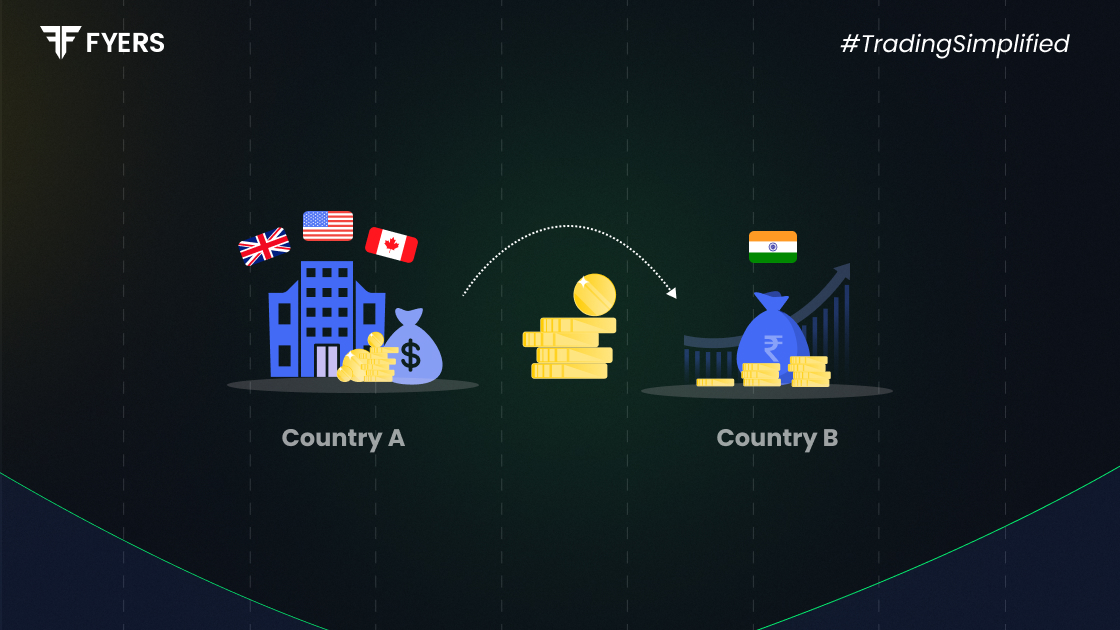

 29 Jun, 2025
29 Jun, 2025
 4 mins read
4 mins read

Foreign direct investment plays a major role in shaping the economic landscape of developing nations like India. It brings in much-needed capital, technology, and employment opportunities, making it a vital source of economic growth. But what is foreign direct investment, how does it work, and what are its implications?
Let’s explore FDI in detail, covering its types, benefits, examples, and the framework that governs FDI in India.
Foreign direct investment refers to an investment made by a company or individual from one country into business interests located in another country. Typically, this involves establishing a new business operation or acquiring a significant stake (usually 10% or more) in a foreign company.
In simpler terms, what is FDI? It is when a foreign investor puts money directly into the productive assets of a company in another country to gain control or a long-term interest.
Understanding how FDI works is key to recognising its broader economic impact. It goes beyond mere capital flow and includes:
Establishing business operations: Such as setting up factories, offices, or joint ventures.
Acquiring ownership: Taking control of existing businesses through mergers or acquisitions.
Bringing in technology and skills: Foreign companies also introduce management practices, technical know-how, and innovation.
Investors choose foreign direct investment when they seek long-term involvement and influence over business decisions.
Types of foreign direct investment can be categorised based on the nature and objective of the investment:
|
Type |
Description |
|---|---|
|
Greenfield FDI |
Setting up a new business from scratch in the host country. Example: A foreign car manufacturer building a plant in India. |
|
Brownfield FDI |
Acquiring or leasing existing businesses or assets. Example: A foreign firm taking over an Indian pharmaceutical company. |
|
Horizontal FDI |
Investing in the same industry abroad as the investor’s domestic business. |
|
Vertical FDI |
Investing in a related industry abroad, often part of the supply chain. Example: A tyre company investing in a rubber plantation. |
|
Conglomerate FDI |
Investment in an unrelated industry, usually for diversification. |
To understand FDI in India, here are some real-world FDI examples:
Walmart’s acquisition of Flipkart: A classic Brownfield FDI move where Walmart took a controlling stake.
Hyundai’s facility in Tamil Nadu: A Greenfield investment that generated significant employment.
Amazon India: Through infrastructure and warehousing investments, Amazon contributed substantial foreign direct investment under permitted routes.
These examples illustrate how FDI contributes to growth, job creation, and market development.
There are two main routes of FDI in India:
Automatic Route
No prior approval is needed from the Indian government or RBI. Foreign investors can invest directly in sectors permitted under this route.
Government Route
Requires prior approval from the government for sectors that are considered sensitive, such as defence, telecom, and media.
The chosen route depends on the sector, country of origin, and ownership percentage.
The benefits of FDI are manifold and essential for national development:
Capital Inflow: Provides foreign capital for infrastructure and industrial growth.
Employment Generation: Creates new jobs and supports skill development.
Technology Transfer: Brings in advanced technology and modern business practices.
Boosts Exports: Foreign-owned companies help expand India’s export capacity.
Improves Infrastructure: Especially in logistics, manufacturing, and services.
Enhances Global Integration: Helps Indian companies enter international markets.
FDI policy in India is shaped by the Department for Promotion of Industry and Internal Trade (DPIIT) under the Ministry of Commerce and Industry. Key points regarding FDI regulations in India include:
Sectoral Caps: Different caps exist across sectors. For example, 100% FDI is allowed in telecom, e-commerce, and pharmaceuticals via the automatic route.
FDI - Prohibited Sectors: Includes lottery, gambling, and atomic energy.
Recent Reforms: Liberalised policies in insurance, defence, and aviation have been introduced to attract more foreign direct investment.
Foreign direct investment has become integral to India’s economic story. It injects capital, fosters innovation, and links India to global markets. With an investor-friendly environment and evolving policies, FDI in India is set to grow further.
Knowing what is foreign direct investment, the types of foreign direct investment, the routes, and regulatory framework helps businesses and investors make informed decisions. As India continues liberalising its economy, FDI will remain a crucial growth catalyst.
FDI is when a foreign company or person invests directly in a business in another country, aiming for control or a lasting stake.
FDI involves control and long-term investment in a business. FII (Foreign Institutional Investment) focuses on financial assets like shares and does not offer control.
Yes, many sectors allow 100% FDI under the automatic route, such as IT, e-commerce, and manufacturing, depending on the FDI policy in India.
Greenfield FDI is investment in a new setup, while Brownfield involves acquiring or merging with existing firms or infrastructure.
Calculate your Net P&L after deducting all the charges like Tax, Brokerage, etc.
Find your required margin.
Calculate the average price you paid for a stock and determine your total cost.
Estimate your investment growth. Calculate potential returns on one-time investments.
Forecast your investment returns. Understand potential growth with regular contributions.